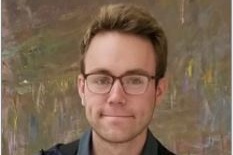CU Boulder’s Beau Farris selected SunLit Writer-in-Residence
Beau Farris, an MFA candidate at the University of Colorado Boulder, has been selected as 2025 SunLit Writer-in-Residence on the Eastern Plains — the third emerging writer to participate in the program co-sponsored by The Colorado Sun.
Farris, 25, describes himself as an experimental writer whose work has been featured in The Indianapolis Review, English Language Notes, Variety Pack, and other journals. He will spend a week this summer engaging with rural life and exploring his creativity in the town of Kirk in northeastern Colorado.

He follows the footsteps of the inaugural SunLit writer-in-residence, Anita Mumm, who was completing her MFA at Western Colorado University, and River Grabowski, who was doing the same at Colorado State University. The residency, under the banner of The Colorado Sun’s weekly literary feature, goes to one student each year selected from MFA programs at Colorado colleges.
The opportunity includes a stipend to help cover expenses and operates in conjunction with Prairie Sea Projects, which focuses on wide-ranging rural creativity from writing to music, film and even biodiverse gardening. It receives support from the nonprofit Prairie Cultural Commons.
Building on its creative residency program launched in 2021 in northeastern Colorado, Prairie Sea Projects has partnered with The Nature Conservancy to create the Prairie Futures Creative Residency Program, of which the SunLit residence is a part. This program has relocated from its original location in Joes to The Nature Conservancy’s 14,000-acre Fox Ranch Prairie Preserve in nearby Kirk.
The location marks a key site within Colorado’s shortgrass prairie ecoregion, demonstrating the balance of agriculture and conservation for climate resilience. The residency supports artists and writers while focusing specifically on the ecological changes impacting rural agricultural landscapes and their surrounding communities.
Farris said his work uses “devices common to visual poetry and experimental writing, and my praxis revolves around the interplay between language, form, and visuality to expand the possibilities of poetic expression.” He added that he experiments with form “in ways that challenge conventional reading habits.”
The SunLit residency has helped connect emerging writers with the under-celebrated Colorado high plains, said Maureen Hearty, co-director of Prairie Sea Projects. She added that the Sun has helped the program, as well as its rural community, “connect with new creative mindsets that have built long-lasting relationships.”
“Through the SunLit Writer-in-Residence program,” she said, “we’re building a living archive of creative work that reflects the realities and beauty of rural Colorado.”
Prairie Sea Projects recently released The Alma Journal, Volume One, a collection of writings from previous writers-in-residence, including a piece titled “The Oasis” by Mumm, the first SunLit writer-in-residence.

